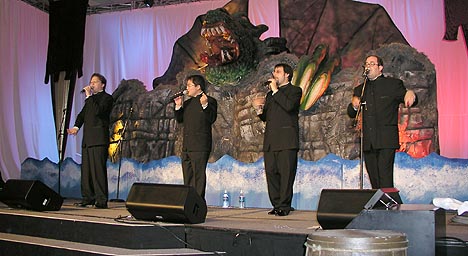

Current Cover
|
|
|
|
|
|
Pen Computing: Major Industry Conference Reports2003 Intermec i-comm Conference in Miami, Florida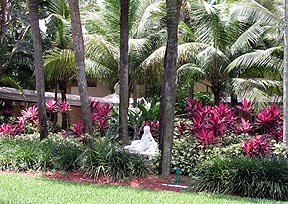 Intermec's 2003 i-comm conference took place May 4 through 7 at the gorgeous Doral Golf Resort in Miami, Florida. Not being a golfer, I missed out on Sunday's golf outing on what is said to be a terrific course. Intermec's company motto is "expect more," and those who came here with high expectations certainly were not disappointed. Intermec's 2003 i-comm conference took place May 4 through 7 at the gorgeous Doral Golf Resort in Miami, Florida. Not being a golfer, I missed out on Sunday's golf outing on what is said to be a terrific course. Intermec's company motto is "expect more," and those who came here with high expectations certainly were not disappointed.
The formal events started Sunday evening with a kick-off by Tom Miller, Executive Vice President of Intermec and former Norand president. A keynote was presented by Patrick Lencioni, a leadership and organizational development expert who, with stints at Oracle and Sybase, seems equally at home in the technological arena as in leadership and management theories.
Welcome address by CEO Larry Brady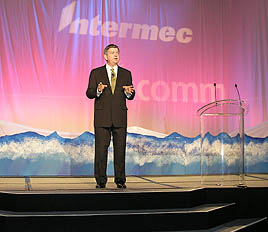 A terrific welcome address was then given by Larry Brady, President and CEO of UNOVA. Brady, an Annapolis US Naval Academy graduate, Harvard Business School MBA, and former president of FMC Corporation has an incredible command of economic and business terminology and managed to use that to analyze and explain current economic conditions and their impact on corporate performance and growth in a truly excellent performance. In a half hour of well-crafted sentences and dense, yet eminently logical slides and visuals entitled "Unwinding the Contradictions and Focusing on the Denominator," Brady calmly analyzed the dramatic fall-off in manufacturing utilization in the year 2000, how it came about, and what needs to be done to reverse the trends. Leading us through cause and impact of financial and economic phenomena over
the past three years, Brady, despite the great complexity of the data, made it all seem simple. He proudly stated that Intermec's sales, despite the weak economy, have grown 13-16% in each of the last three quarters. A terrific welcome address was then given by Larry Brady, President and CEO of UNOVA. Brady, an Annapolis US Naval Academy graduate, Harvard Business School MBA, and former president of FMC Corporation has an incredible command of economic and business terminology and managed to use that to analyze and explain current economic conditions and their impact on corporate performance and growth in a truly excellent performance. In a half hour of well-crafted sentences and dense, yet eminently logical slides and visuals entitled "Unwinding the Contradictions and Focusing on the Denominator," Brady calmly analyzed the dramatic fall-off in manufacturing utilization in the year 2000, how it came about, and what needs to be done to reverse the trends. Leading us through cause and impact of financial and economic phenomena over
the past three years, Brady, despite the great complexity of the data, made it all seem simple. He proudly stated that Intermec's sales, despite the weak economy, have grown 13-16% in each of the last three quarters.
Moving on to drawing conclusions from his formidable analysis, Brady then pondered how to secure the future of organizations. How can we finance business growth and raise share price without greatly increasing assets? Citing Dell as a shining example (shares up 30,000 percent since the company went public), Brady demonstrated that what mattered was not gross margins or profit margins (all areas where Dell only performs adequately), but that the secret is return on assets, an area where Dell excels. Return on assets largely depends on working capital asset efficiency. A good part of that is highly efficient inventory turnover, which gets back to supply chain management, which happens to be Intermec's core strength. Brady went on to say that the conventional view of why customers buy Intermec products and services is to simply make people more efficient. The new view is that Intermec extends the supply chain management and its proper use and handling. AIDC (Automatic Identification and Data Capture) is growing much faster than the rest of the industry. All of this, plus the fact that Unova has paid down almost all of its debt, places the company in a good position. Brady presented a graph that shows Unova/Intermec stock greatly outpacing that of main rivals Symbol technologies and Zebra, and also the SP500. All in all this was one of the best presentations on economic theory and its practical applications I have ever seen. Brady is a dynamic presenter with an unbelievable command of financial terminology and a man who clearly came across as a true captain of industry. That impression was confirmed when I had the honor of talking to Mr. Brady during dinner for a few minutes. Brady then introduced guest keynote speaker Adel Al-Saleh, General Manager of Global Wireless -Business at IBM, mentioning during the introduction that Intermec's very successful 700 Series (almost 100,000 sold) went from 30 to over 90% wireless implementation during the last year. "The new generation of wireless e-business."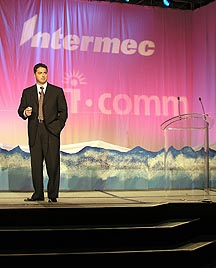 The Monday keynote was given by Adel Al-Saleh, General Manager, global wireless e-business, IBM. The topic of Mr. Al-Saleh's presentation was "The new generation of wireless e-business." He quoted IBM CEO Sam Palmisano who said that those who will succeed in this new economy will use unprecedented levels of integration to get on-demand performance. Al-Saleh pointed out that the market landscape has taken unreal blows--Dotcom, 9/11, scandals, political upheavals--and that it is remarkable that we still do see growth at all. Some of this he attributes to new wireless technologies and applications. The crucial point is that wireless allows the capture of information at the place where it is created and passed on to where it is needed so that it can be processed and decisions can be made. Hence, wireless will be seen more not only in standalone or ancillary projects but more and more in core business applications and in true CRM applications. He said that 65% of major enterprises will deploy at least one pervasive wireless application this year. This alone amounts to $200 billion in business.
Like Brady, Al-Saleh stressed the complete focus on demonstrable return on investment. The time where technology was bought for technology's sake is over. In order to succeed: The Monday keynote was given by Adel Al-Saleh, General Manager, global wireless e-business, IBM. The topic of Mr. Al-Saleh's presentation was "The new generation of wireless e-business." He quoted IBM CEO Sam Palmisano who said that those who will succeed in this new economy will use unprecedented levels of integration to get on-demand performance. Al-Saleh pointed out that the market landscape has taken unreal blows--Dotcom, 9/11, scandals, political upheavals--and that it is remarkable that we still do see growth at all. Some of this he attributes to new wireless technologies and applications. The crucial point is that wireless allows the capture of information at the place where it is created and passed on to where it is needed so that it can be processed and decisions can be made. Hence, wireless will be seen more not only in standalone or ancillary projects but more and more in core business applications and in true CRM applications. He said that 65% of major enterprises will deploy at least one pervasive wireless application this year. This alone amounts to $200 billion in business.
Like Brady, Al-Saleh stressed the complete focus on demonstrable return on investment. The time where technology was bought for technology's sake is over. In order to succeed:
Al-Saleh expressed great satisfaction with Intermec/IBM cooperation and listed several projects where Intermec partnered with IBM to produce superior solutions. He mentioned Johnson Diversey as an example, and Metro AG with 2,200 stores in Europe which uses wireless to help inventory management. He also listed biometrics and security as growth industries in the wake of terrorist attacks and threats and increased security requirements. The key to it all, said Al-Saleh, is to be able to respond quickly to customer requirements. And wireless solutions can do that.
What followed next was a smorgasbord of breakout sessions and tracks. No fewer than seven competed for attendees' attention (in addition to the golf course and the pool!) and it was difficult to pick. I wanted to learn more about Intermec's commitment to Bluetooth and therefore went to: Tips and Tricks for Enterprise Bluetooth deploymentThis session was presented by Brian Kristiansen and Joe Bridge of Intermec. They provided an overview of Bluetooth basics: Bluetooth is a global wireless radio standard primarily meant to replace cables. It uses spread spectrum technology but runs ten times slower than 802.11b and operates within roughly ten meters, or 33 feet. Market research firm IDC predicts that two million Bluetooth devices will be in operation before the end of 2004. Key features of Bluetooth are its robustness, its lack of complexity, its very low power requirements, and its low cost. Even in a vertical market device like Intermec's 700 Series industrial Pocket PCs, the Bluetooth price premium is just $140. Intermec uses Bluetooth for communication with printers, GPS units, Wide Area LANs, scanning, and more.Brian and Joe then demonstrated Bluetooth "device discovery." Somewhat their surprise they found no less than seven Bluetooth devices in the audience (including my Bluetooth-equipped iPAQ). They showed how to select devices, select favorites, and "bond" with them. The device discovery process seems to take quite a bit of time when there are multiple Bluetooth devices in the vicinity. They demonstrated how an Intermec handheld can discover and bond with a printer, a phone, or a scanner. They also showed Bluetooth security, such as PIN codes, or turning of discovery. They also showed that there was no interference between 802.11 and Bluetooth, both of which operate on the same band. Frequency hopping goes a long way to eliminating conflicts. My impression was that we are starting to see more Bluetooth standardization but that there are still a good number of steps to the process. Using Bluetooth can be a bit confusing. However, those steps seem actually no more complicated than setting up LAN access or dial-up. For each function you can enable or disable and also protect or require authorization. The Intermec 700 Series' Core utility automatically installs the appropriate drivers if a Bluetooth device is discovered. Printing actually goes through the com port. Intermec has a Wireless printing SDK and a socket API, all on the Tools CD. By early 2004 Intermec will release a Bluetooth Device Utility that will make everything easier. The utility will handle multiple default printers, auto configuration, remote setup, and the management of multiple apps. They also mentioned some third party products, among them NiceWare's Pocket NiceLabel. In conclusion, Brian and Joe stated, Bluetooth has many advantages: it's inexpensive, there is an explosion of Bluetooth support, and you'll be able to do away with expensive, finicky cables. After the session, Intermec's ever helpful Mike Colwell told me that the company considers adding Bluetooth to much of the product lineup. Feeding Hungry People using Intermec devicesThe title of this session had caught my eye because it is not something I would normally expect at a technology conference. "Feeding hungry people using Intermec devices?" Turns out that it was about the Gleaners Community Food Bank in Metro Detroit whose mission it is to collect and distribute food to agencies feeding the hungry. And the Food Bank is using Intermec equipment to handle and process all that food.The session was presented by Gleaners President Agostinho Fernandes, a smart, compassionate man who decided to leave his corporate career in food supply line management to help people. He stated that he is unusual in other respects as well. Whereas many of those who dedicate their lives to good will causes are liberals, he is a conservative Republican. Fernandes explained that the Food Bank was founded in 1971 by a Jesuit brother by the name of Gene Gonya who had returned to his family farm and donated food to the poor. He called the food bank "Gleaners" in reference to the bible's description of people gleaning crops. Today, every day 50,000 people are nourished via food banks, and the organization's mission is to make sure that no one in Southeastern Michigan goes hungry. The way it works is that Gleaners receives surplus and donated food, inventories and processes it, and then passes it to over 300 agencies. In total, they handle 1.6 million pounds of food every month. This essentially makes Gleaners a supply chain with traditional supply chain management issues. The problem, Fernandes explained, is that they must do ever more with less and less. Over the past year he has seen a 20% increase in need. The "agencies" (the term for whatever place eventually prepares and gives the food to the hungry) help support Gleaners from their own meager sources. However, although Gleaners can legally receive as much as 18 cents per pound of food, the actual amount received went down from 8 to 3 cents per pound between 1986 and 2001. During that time food Gleaners distributed increased from eight to 25 million pounds. Among the many challenges Fernandes' group and many others face are rising unemployment, rising food costs, and, ironically, many well meant donations going to the wrong places. For example, after the 9/11 disaster, tons of food went to New York City where it actually wasn't needed. Fernandes said Gleaners is heavily into technology. When he joined the organization he found that, in general, food banks are not run like businesses. Coming from corporate food distribution, he sought to emulate private enterprise food distribution. Unfortunately, no off-the-shelf system could handle the extra requirements and realities of a food bank. Eventually they teamed up with SYS-TEC to develop a food bank warehouse management system using bar codes and bar code readers. Having worked with Intermec equipment in his corporate career, Fernandes looked to Intermec for the equipment. Gleaners first used Intermec vehicle-mount terminals, then switched to a real-time system using Intermec 2425 wireless handhelds, MobileLan Access points, and EasyCoder 3400 barcode printers. Intermec was happy to participate in this worthwhile project and offered "a great price" (the company has a special price list for food banks, of which there are about 200 in the United States). So Fernandes began handling the logistics of Gleaners according to the same principles he used in corporate settings. He viewed the entire process as managing a supply chain. That entailed management of inventory turnover, tracking labor, managing facilities and assets, and making sure the customers are happy. There were some of feared that the barcoding technologies' complexity would be too much for Gleaners' undereducated staff. That did not turn out to be the case at all. Fernandes explained how the tags were developed so that the people understood the concept and how it all fit together. Everyone rose to the occasion. "When we have visitors," Fernandes proudly explained, "they do all the technology demonstrations!" The state-of-the-art system has helped Detroit Gleaners, the seventh largest in the US, make one of the most efficient food donation distributors. Before the system was implemented, 14 million pounds of food were handled by six people. Today, 24 million is handled by just three. In addition, the system helps with the numerous audits Gleaners must pass as a non-profit organization. In those audits, inventory is checked with Intermec scanners. Fernandes frequently praised Intermec's participation in this project. He said he found their equipment to be truly more rugged than others, he appreciated the pricing. He also mentioned that Intermec had donated office equipment to Gleaners. Fernandes' presentation (which deserved a much greater turnout than the seven or eight people who showed up) included some interesting insights. He related how Gleaners gets its food. Often it is over-production of an item, or packages with labels printed wrong or upside down, or things like Wheaties boxes featuring stars who did either not perform as anticipated or who had fallen from grace. He also mentioned the logistics of getting the right food to the right place. Avocados sent to the wrong neighborhoods, for example, would be left untouched whereas they are treasured and snapped up in others. He also said that many organizations make special efforts to collect food for food banks. The National Association of Letter Carriers, for example, collects food on Saturday May 10. In such instances, very large amounts of food must then be processed and managed in a short time. Fernandes mentioned that the next generation of Gleaners food bank management system would use Navision/Ceres software, and again Intermec hardware, as a result of Gleaners' joining America's second Harvest Enterprise project. Second Harvest is a Chicago-based national network of food banks. For more info see www.gcfb.com and www.secondharvest.org. Overall, I felt this was a most heartwarming presentation that gave a technology company like Intermec a passionate, human face. Intermec Partner and Product Showcase No industry gaterhing or conference would be complete without a product showcase. For many this is the highlight of a conference as it allows them to see the latest products all in one place. It's also a great opportunity to mix and mingle with product managers and marketing people and gets some hands-on experience with solutions that can make a difference. No industry gaterhing or conference would be complete without a product showcase. For many this is the highlight of a conference as it allows them to see the latest products all in one place. It's also a great opportunity to mix and mingle with product managers and marketing people and gets some hands-on experience with solutions that can make a difference. 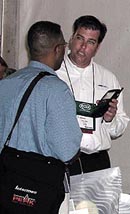 This year's i-comm Product Showcase took place in a giant tent and featured a much larger number of vendors than I expected. Pretty much everyone offering anything of value and interest to Intermec customers and developers, current and prospective, was present and accounted for. i-comm's organizers thought of a clever way to encourage the crowd to visit all tables and exhibits, not an easy task given the open bar, delicious buffet, and great company. How did they do it? By making you collect stickers of different color fish that you could pick up at vendor tables. Get all the fish and you could participate in the drawing for prizes. Getting the first dozen or so was easy, but the remaining two or three proved difficult. Sneaky devils, those organizers. But just like mom who made you do stuff for your own good, I ended up learning quite a bit on my quest for elusive purple fish I needed to complete my card... This year's i-comm Product Showcase took place in a giant tent and featured a much larger number of vendors than I expected. Pretty much everyone offering anything of value and interest to Intermec customers and developers, current and prospective, was present and accounted for. i-comm's organizers thought of a clever way to encourage the crowd to visit all tables and exhibits, not an easy task given the open bar, delicious buffet, and great company. How did they do it? By making you collect stickers of different color fish that you could pick up at vendor tables. Get all the fish and you could participate in the drawing for prizes. Getting the first dozen or so was easy, but the remaining two or three proved difficult. Sneaky devils, those organizers. But just like mom who made you do stuff for your own good, I ended up learning quite a bit on my quest for elusive purple fish I needed to complete my card...
But seriously, the product showcase was great. At times we all forget that all those solutions that increase productivity and yield a great return on investment consist of integrated solutions that are not just hardware, but an optimized system of hardware, software, peripherals, integration and services. The showcase brought all of them together.
Mingling with Intermec Brass The evening brought a terrific dinner at The Doral's Windows on the Green restaurant where we got to mix and mingle with Intermec marketing staff and executives. UNOVA CEO Larry Brady himself came over to our table and presented his views on the state of Intermec and various other issues. This was also an opportunity to thank all of Intermec's inhouse and contributing PR vixens. Katie Andersen, Jennette Graves, Lois Fenimore, Shelby Kraus (the latter two in the picture to the right), et al did a super job. The evening brought a terrific dinner at The Doral's Windows on the Green restaurant where we got to mix and mingle with Intermec marketing staff and executives. UNOVA CEO Larry Brady himself came over to our table and presented his views on the state of Intermec and various other issues. This was also an opportunity to thank all of Intermec's inhouse and contributing PR vixens. Katie Andersen, Jennette Graves, Lois Fenimore, Shelby Kraus (the latter two in the picture to the right), et al did a super job.
Secure the future with Intermec Solutions.Tuesday's opening session was presented by Intermec Vice President of Product Development, Dick Mahany. His talk was entitled "Secure the future with Intermec Solutions." Like Monday, the speech was preceded by a very well done video case study, this one on old Dominion Freight Lines, a shipper that moves everything from one location to 38 States. Old Dominion uses Intermec technology in their dockyard management and numerous other systems, all totally integrated. The company handles 20,000 shipments a day. Each gets scanned about six times a day with Intermec scanners and wireless devices. They save 50 cents on every shipment processed that way, resulting in a return on asset better even than they expected.
Until 2000 everything in IT spending went fine then there was a sharp drop. Today, ideas of what constitutes a successful business in the future are sort of up for grabs. Business strategies are quickly changing. One thing is for sure: ROI models becoming more important and more complicated. What does all that that mean to product planning? There is still some simple observation. But industry marketing experts help identifying new needs and opportunities, and there is the ever important customer feedback. Supply chain costs, time to market, unique products, global marketplace all have been identified as key customer needs. This leads to a number of must have deliverables for Intermec. Durability has also been identified as a key feature. Customers find features like the 3-foot plus drop stat important, as they do the impression and look of durability and toughness. On the non technology side, service and reliability are key. The latter is not surprising given that the operational life of many customers' equipment is seven years! So while there is a strong move towards Pocket PC, even by 2007 one in seven rugged handholds will still run DOS. Intermec knows that legacy and continues to support it. On the new technology front, wireless adoption soars and the majority of Intermec products will include it. In terms of markets, government and security business is linked more than ever. Almost every piece of government equipment has an Intermec barcode attached to it. And now Intermec wants to help the government to go beyond that with even more advanced RFID systems. Industrial management has taken big cuts as an industry and changes were needed. Just in time becomes just in sequence, etc. Retail is another very low margin industry. Great growth opportunity for Intermec in helping them stream line operations. So guiding principles now are high value products, extending customer investment, meet future needs, support open standards, and concentrate on durable, rugged products. Mahany mentioned the new CV60 VMU vehicle mount PC. He also stressed software tools and particularly .NET and gave a brief description of what it actually is--a language of terms on how applications function and how they work together. Available in early versions now. .NET is an idea, he claims, is that Microsoft, IBM, Sun etc all agreed on that. The company launched several new printers, including Bluetooth and other wireless options, and they represent a good part of Intermec business. Wireless connectivity and management uses both Intermec and third party components. As far as Access Points go, Intermec will concentrate on rugged APs, and use Cisco products for all other applications. He highlighted Intermec's tiny new scanning engine less than an inch square. RFID is based on IBM gamma chip technology which has a long range of about seven meters. They also worked extensively with standards bodies to develop all those numerous standards for scanning. Intellitag he says will change the way supply chains are managed. All in all, 22 new hardware and software product will be released in 2003. And next year, Mahany said, there will be a Linux based terminal. The session closed with yet another of those great case study videos. This one was on France's InterMarche supermarkets known as Les Mousequetairs. Once again, all based on bar codes. Tuesday brought four more rounds of seven competing breakout sessions. Once again it was time to choose and l truly regret not having been able to attend all of them. Here are summaries of the ones I attended: Selecting the Best Scanning TechnologyIn this session, Intermec's Dan Bodnar and Tracy Hillstrom (shown making a point in the picture below) discussed current and near-future scanning technologies and which type is best suited for what kind of jobs. As someone who rarely deals with scanners even though they are available for many of the industrial products Pen Computing Magazine reviews, I really appreciated this education.
Laser scanners are used when scanning longer distance in bright light aid where 1-D bars are common. They are very precise, easily visible, and work over long distances. Linear imagers use a broad based light source, more like a flashlight than a laser. The light is then collected and focused onto a linear image sensor. This kind of scanner "sees" poor quality codes better and faster. Linear imagers offer high reliability, are better at scanning difficult codes, can read codes with plastic overlays, and are inexpensive. However, they are not for long range scanning, no 2-D matrix codes, and you can't see the scan line at longer distance. Most of Intermec's scanners are shorter range. Linear imaging is best for short distanced poor quality Codes. Area imagers provide lighting by an array of LEDs. They take a digital image and convert it to black and white. They can read all bar codes. They can also do image capture, are very reliable, can read multiple code at a time, can do OCR, and even biometrics. But it is difficult to see scan lines, no long distance scanning is possible, they have high power consumption, and they are not as quick due to lots of processing. In terms of technologies, Active Pixel Sensor CMOS sensors are the new thing. They are smaller, lower power, more reliable, and driven by digital cameras, plus they offer other advantages over conventional CCDs. Since this is Intermec all of the scanner products must be very durable and rugged, going through numerous tests. Most scanners carry an IP54 rating. Many new standards especially are being developed for small and difficult to mark parts. All of these must be accommodated and handled reliably. Bodnar mentioned BMW that uses a special bar code for manufacturing of the new Z4 sports car which is custom produced and the code shows all the options. Next came a Video of extreme drop tests from 13 feet, comparing products from HHP, Symbol, and Intermec. Symbol and PSC Powerscan survived 7- 18 drops whereas the Intermec 1400 Vista still worked after 50 drops. The better drop performance is a combination of housing and technology used. Retail also has new standards: RSS (Reduced Space Symbology), GTIN (Global Trade Item Number), UPOS (Unified Point of Service). Most of these are stacked codes. Another live shootout between a laser Symbol Cobra and a Intermec linear imaging Scan Plus Vista showed the Symbol unable to read some scans and three times slower for the Whole batters. There seems to be a migration from laser to area imaging. Right now Intermec is about half-half Laser/area imaging. One problem was that area imagers are larger and are just now being available in very small modules. Bottom line of this session: the application drives the technology; pick the one that is optimal. 700 Series Mobile Computers: a new standard for the enterprisePresented by Rich Sherman, Craig Miller, and Karla Marcks of Intermec.Intermec is justifiably proud of their 700 Series of durable Pocket PCs and this session provided an overview of the platform. Rich Sherman started with a big-picture of legacy products and the migration to new lines. He, just as Mahany had done, stressed the relevance of the .Net Compact Framework that provides the write-once/run-on-many setting. He covered wireless security strategy, device management with the ability to manage multiple device types and provide software updates and backups. Sherman also highlighted Intermec's numerous industry firsts.
Karla Marcks, product manager of the 700 Series, portrayed the line as a product that greatly exceeded expectations. It is the fastest selling Intermec product ever, 100,000 in less than two years. The original 705/710/720 use StrongARM processors whereas the latest 740/750/760 models use XScale PXA255 CPUs. All have three radio capability that all can be used simultaneously without even giving up Flash storage. Marcks stated that Bluetooth seems over the "hype curve" and now greatly increases connectivity of the 700 with many devices. Schwan's home delivery of fine foods, for example, uses Bluetooth equipped 700s to print receipts. Also available linear imager and area imager that practically adds not only a very versatile scanner but also a digital camera. Alpha numeric keypad available now and 128mb soon. Plenty of options including docks and handles. Some options only available on the color models, so check specs.
I picked the next session because it appeared to discuss an innovative new technology pilot by one of the more important federal agencies, the Social Security Administration. Social Security Administration successfully pilots RFID for Fleet Management Control and Supply StoreThis was a very well presented session carried by a 42-year veteran of the SSA, Harold Brittingham, with demonstrations and elaborations by Gary Orem. The topic was the SSA's experimental use of RFID technology to save money in various ways.Radio Frequency Identification technology uses electromagnetic signals in passive or active tags. The signals transmit up to 40 feet. Identification does not require contact or line of sight. RFID is similar to barcoding, only the information is read by radio receivers instead of barcode scanners. The tags currently cost between one and three dollars a piece. Price will come down as volume goes up (Brittingham mentioned Gillette will buy 500 million tags over next few years). Although RFID has been around for about seven years, it is still an emerging technology. Brittingham said he expects the SSA, who spent only about 11,000 dollars on the initial pilot project, to eventually save millions of dollars using it. The pilot wasn't entirely smooth going. The initial vendor didn't work out. Eventually Radio Beacon partnered with them via Intermec. There were also turf battles over who was responsible over what. In order to keep the pilot simple, the team chose to use it for the number of business processes in the SSA's Self Service store. That would give them an idea if it could be used to monitor user access and handle supply chain management. The goal was better user satisfaction, better accuracy, and saving money. SSA stores have forms and supplies and other office materials for some 10,000 people. Since the tags are relatively expensive and many of the store's items were not, they decided to restrict the pilot to four higher price items. They also created a user access validation system where a card with an intelligent tag keeps track of who goes in and out, and whether their access is expired or not. The system tracked tagged items and the results could be passed on to inventory control. Once a tagged item ran low the system automatically generated an order. The order was then processed by the warehouse. The result of the pilot was very encouraging. Readability was 100% accurate, validation was successful, and read distance was five to seven feet. However, since 85% of the store's items cost less than a dollar full implementation will have to wait until tags become cheaper. The success of the store project made them decide to try RFID with a Fleet Management Program. SSA staff requests cars via a web-based system. They figured that using RFID tags would enable them to maintain a more accurate inventory of where the cars were, when they came in, when they left. So each vehicle was equipped with a tag. A system was developed and linked to existing web system. It, again, worked well and captured all the desired information for processing and report generation. The savings in paperwork alone are expected to amount to $60k a year. Brittingham mentioned other possible applications, such as using RFID tags to track gas usage by having tags open and lock tanks and fuel pumps. Both initial pilots worked great. Now they are looking at a number of other apps that could result in great savings. Asset tracking a huge priority. They have 170,000 assets costing $325 million. Supply chain management and Social security Cards. The biggest deal would be Folder Tracking. This deals with disability claims. These can take over a thousand days with many days lost. Tags on folders could automatically issue requests and reminders. This could be huge as it is one of the biggest complaints. Orem did a rather convincing demo where almost everything worked (the tags were a bit slow in being recognized). He mentioned, however, that this is a technology still under development. Voice over IP: Realizing the Value of a Converged VoIP SolutionKaren Pearson of Intermec highlighted the exciting potential of Voice over IP that had been brought up several times during the conference. She pointed out that even today, 70% of all Fortune 1000 use Voice over IP. It is a large business already.
VoIP can lower overall deployment cost of the wide area network. There are fewer devices to keep track of. It is, for the most part, a software-only solution. It allows subnet roaming, and has slew of security options. Calls can be facilitated and limited in numerous ways. In keeping with the conference's overall underlying emphasis on ROI, Pearson showed how even a small installation where ten low-pay employees use VoIP instead of cellphones could easily save $10,000 a year, compared to a total investment of $5,000 for server and clients. She said in situations where workers roam premises, scanning and being asked questions via phone, the ability to look up information and provide answers right away not only saves time, but also greatly increases customer satisfaction. She said such solutions could easily save an hour a day per person in productivity. And peer-to-peer calls do not even need a server. VoIP is available on all Intermec Windows devices and those that use Windows CE 4.0 and higher. Final Night Dinner and Entertainment: "A Knight to Remember"A knight to remember.... And so it was. Yes "knight," not night. That's because the whole huge Doral Grand Ballroom was magically transformed into sort of a giant version of a mediaeval dinner hall. The entrance had a large gate with jesters and welcomers and guards. Inside, tables were arranged in long rows and adorned with tall silver chandeliers with 2-1/2 foot white candles. Usually most people are gone by the last evening of an event, or they go sightseeing, but that was definitely not the case at the Intermec Conference. This was a grand and elegant grand and very well attended affair. On the stage was a huge dragon with fearsome claws that spit up smoke every now and then, adding to the mysterious surroundings, Jubilant jesters and artists, all decked out in mediaeval garb, performed stunts and entertainment. A quartet of ladies in period attire played renaissance music.
The grand act of the evening, the musical entertainment was provided by, yet another surprise, not Robin Hood or some group of singing nights, but a curious singing comedy quartet of guys dressed in black tuxedos. They looked like priests and came from Washington DC. They mixed comedy with song and personality in a flurry of hilarious and hilariously funny parodies in different styles. There was a song on notebooks not booting and going after Bill Gates, one on liposuction, a dramatic rendition of Secret Agent Man, only this was "Secret Asian Man" as one of the singers was Chinese. They poked fun at boy bands by singing a generic song with placeholder for the usual banal verbiage, they lampooned internet porn, performed a catholic hymns, and then organized a conga line led by Intermec brass (who had no choice but rising to the challenge as the dynamic quartet swore Symbol had done one hell of a line the Week before). They did well. Heck they even got, according to them, the first ever encore at a corporate event. A perfect formal ending to a conference that mixed business, technology, mingling and fun.
Unfortunately, l missed Wednesday morning's featured speech by Intermec Senior VP Steve Winter where, according to a colleague who attended, the presenter stressed good old-fashioned customer contact and customer relation. At times we forget in this world of the web and fully automated this and that that after all is said and done we're still people, social animals who seek and appreciate contact with other people. Intermec knows that, still knows that, and nowhere was this better demonstrated than during this conference. Intermec did a bang-up job on this one. I won't forget it soon, and neither will the large crowd of customers, resellers, VARs, and developers who attended. Next year's conference, i-comm 2004, will be held at the Chicago Hilton May 16 through 19. |
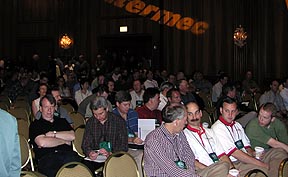
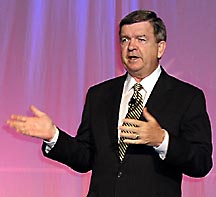 Brady then spent some time outlining the new trends in capital expenditures. There's a growing aversion to debt and an increase in outsourcing. Both mean that supply chains become more difficult. In this climate, ROI, Return On
Investment, once again becomes the prime valuation criterion. Good leadership becomes essential; value again becomes more important than simple growth. In the 1990s, growth at all costs was accomplished via acquisitions, resulting in substantial debt. That is always a dangerous position, and became a disastrous once corporate profits declined.
Brady then spent some time outlining the new trends in capital expenditures. There's a growing aversion to debt and an increase in outsourcing. Both mean that supply chains become more difficult. In this climate, ROI, Return On
Investment, once again becomes the prime valuation criterion. Good leadership becomes essential; value again becomes more important than simple growth. In the 1990s, growth at all costs was accomplished via acquisitions, resulting in substantial debt. That is always a dangerous position, and became a disastrous once corporate profits declined.
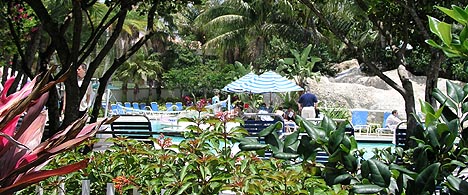
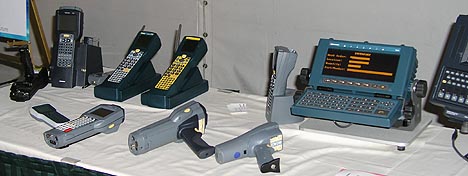
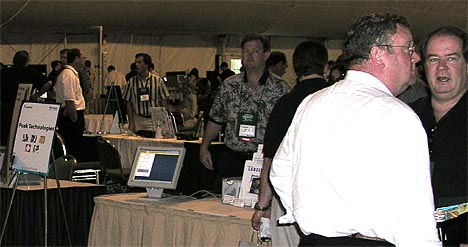
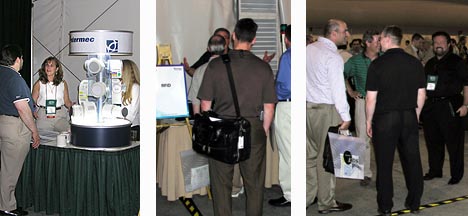
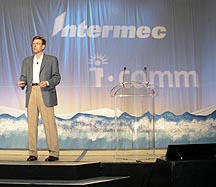 "The focus," Mahany began, "is no longer on technology itself but on what people and companies can do with it." He proudly mentioned that thanks to the 700 Series of ruggedized Pocket PCs, Intermec is now one of Microsoft's top ten Pocket PC producers. He also stated that this year Intermec will introduce more new products thin ever before. Still, he went on, the future can never be totally predicted. In 1975, when computers still cost hundreds of thousands of dollars, Gordon Bill predicted that by 1995 $500 computers would be available. He based that prediction on some simple formulas and operations. And he was pretty much on target.
"The focus," Mahany began, "is no longer on technology itself but on what people and companies can do with it." He proudly mentioned that thanks to the 700 Series of ruggedized Pocket PCs, Intermec is now one of Microsoft's top ten Pocket PC producers. He also stated that this year Intermec will introduce more new products thin ever before. Still, he went on, the future can never be totally predicted. In 1975, when computers still cost hundreds of thousands of dollars, Gordon Bill predicted that by 1995 $500 computers would be available. He based that prediction on some simple formulas and operations. And he was pretty much on target.
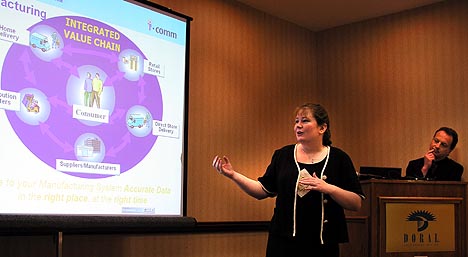
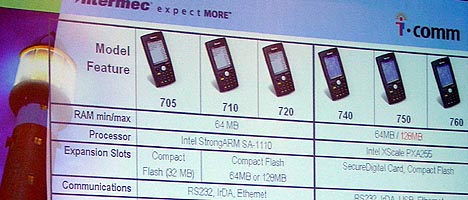
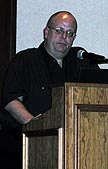 Craig Miller (see image to the right) mentioned Intermec's Voice over IP client and server products that make voice calls on 700 models possible even while they do other work. This can eliminate cellphones and Walkie-Talkies. And it can also limit calls to within a network, or impose other restrictions. Miller said VoIP offers remarkable sound quality. GPS, Miller said, is also ever more important. GPS accuracy is now between three and meters since the intentional selective availability was turned off by the DOD in 2000. He also mentioned the
Craig Miller (see image to the right) mentioned Intermec's Voice over IP client and server products that make voice calls on 700 models possible even while they do other work. This can eliminate cellphones and Walkie-Talkies. And it can also limit calls to within a network, or impose other restrictions. Miller said VoIP offers remarkable sound quality. GPS, Miller said, is also ever more important. GPS accuracy is now between three and meters since the intentional selective availability was turned off by the DOD in 2000. He also mentioned the 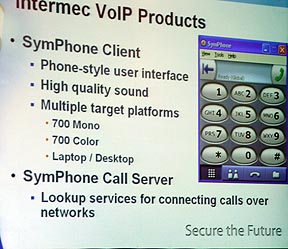 She explained a standard setup built around the SymPhone VoIP engine by Tellis that Intermec uses. It consists of one or more SymPhone servers and clients on each device. Each site should have a server. If a client wants to place calls to standard phone numbers they need an interface to the standard phone system.
There are many benefits to Voice over IP. In situations where workers have to use their equipment while at the same time answering calls or passing on voice information, they no longer need multiple devices. This means that they can do without an array of pagers, cellphones, and walkie-talkies. And those who expect scratchy, delayed, unreliable "Internet sound" the way it used to be a couple of years ago will be surprised. Today's VoIP systems offer excellent sound.
She explained a standard setup built around the SymPhone VoIP engine by Tellis that Intermec uses. It consists of one or more SymPhone servers and clients on each device. Each site should have a server. If a client wants to place calls to standard phone numbers they need an interface to the standard phone system.
There are many benefits to Voice over IP. In situations where workers have to use their equipment while at the same time answering calls or passing on voice information, they no longer need multiple devices. This means that they can do without an array of pagers, cellphones, and walkie-talkies. And those who expect scratchy, delayed, unreliable "Internet sound" the way it used to be a couple of years ago will be surprised. Today's VoIP systems offer excellent sound.

